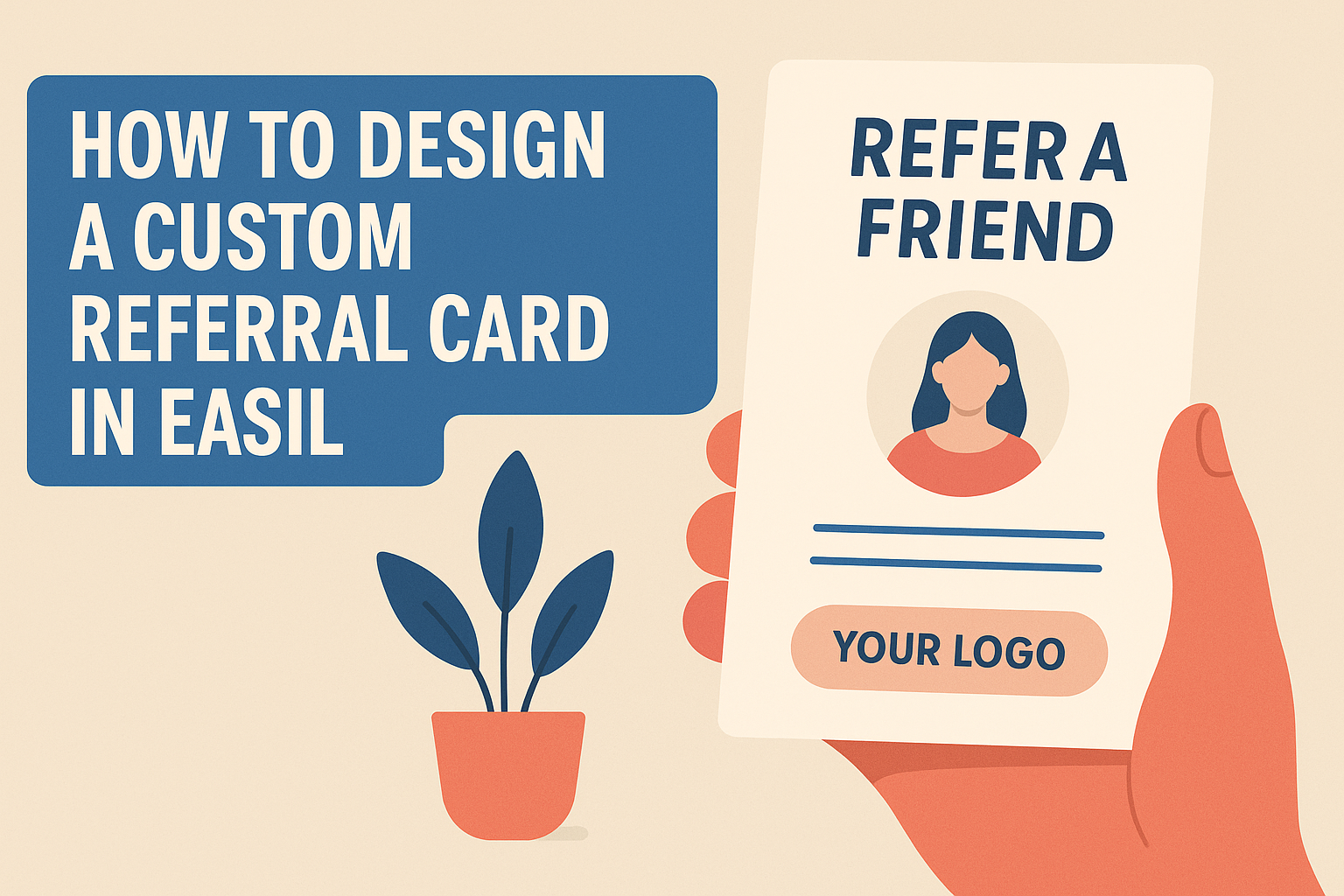Designing a custom referral card can be a fun and creative way to promote a business or service.
Easil makes it easy to create a unique and eye-catching card that reflects personal style and branding.
With its user-friendly interface, anyone can design professional-looking referral cards in just a few simple steps.
To get started, users can choose from a variety of templates available in Easil’s library. They can customize each element, from fonts to colors, ensuring their referral card stands out.
By utilizing these features, businesses can effectively engage their audience and encourage referrals.
Creating a referral card not only enhances brand visibility but also helps in building a loyal customer base. With Easil’s tools, anyone can turn their ideas into a beautiful design that drives results.
Understanding the Basics of a Referral Card
Referral cards play an essential role in marketing by encouraging customers to share their positive experiences. They are simple tools designed to drive new business through recommendations.
This section discusses the purpose of referral cards and the key design elements that make them effective.
Purpose of Referral Cards in Marketing
Referral cards are powerful marketing tools that help businesses attract new customers. They work by allowing existing customers to recommend a product or service to their friends and family.
When someone receives a referral card, they often feel more inclined to try the business. This is due to the trust built through personal connections.
Businesses frequently offer rewards for both the referrer and the new customer, enhancing motivation to share.
This kind of marketing not only expands customer reach but also fosters loyalty among existing customers. By focusing on personal recommendations, referral cards create a friendly, inviting atmosphere around the business.
Design Elements that Encourage Sharing
The design of a referral card is crucial for its success. Key elements can influence how likely people are to share them.
Here are some important design features:
- Clear Messaging: The card should clearly state the offer and benefits.
- Attractive Visuals: Use eye-catching colors and images to grab attention.
- Easy-to-Read Text: Make sure the text is legible, focusing on essential information.
- Space for Personalization: Allow customers to add their details, personalizing the card for their friends.
These elements together create a visually appealing card that encourages sharing. A well-designed referral card motivates existing customers to hand it out and invite others to join.
Designing Your Referral Card in Easil
Creating a custom referral card in Easil is an exciting way to promote your business. Focus on selecting the right template, using effective customization techniques, and adding personalizable fields to enhance appeal.
Selecting a Template Suitable for Your Brand
Choosing the right template is the first step in designing a referral card. Easil offers many pre-designed templates that can suit various businesses.
When selecting a template, consider the following points:
- Brand Colors: Look for templates that can easily incorporate your brand colors.
- Layout: Ensure the layout highlights the rewards for both referrer and friend.
- Visuals: Select a design that allows for engaging graphics or logos.
Easil’s user-friendly interface makes it easy to preview templates before deciding. This helps in ensuring that the chosen template aligns with the brand’s identity.
Customization Techniques in Easil
Customization is key to making a referral card unique. In Easil, users can modify templates to better fit their style. Here are some effective techniques:
- Fonts: Choose fonts that reflect your brand’s personality. Use bold or italic styles for emphasis.
- Colors: Utilize the color picker to adjust hues and create visually appealing designs.
- Images: Upload high-quality images or use Easil’s image library to find the perfect graphic elements.
Easil provides options for aligning and arranging components as well. Users can easily adjust sizes and placements to create a balanced look.
Adding Personalizable Fields
Personalizable fields make referral cards more engaging. Easil allows users to add fields that can be customized later by clients or recipients.
Key personalizable elements include:
- Referrer Name: A field for the person who is recommending can add a personal touch.
- Referral Code: Include a unique code that each referrer can share with friends.
- Expiration Date: Adding a date can create a sense of urgency and drive action.
These features not only enhance usability but also increase the chances of referrals. By incorporating such fields, businesses can enjoy more effective marketing campaigns.
Printing and Distribution Strategies
When creating custom referral cards, the choice of materials and how they are distributed are crucial. Selecting the right paper and finish can enhance the card’s appeal, while effective distribution channels can maximize reach.
Choosing the Right Paper and Finish
Selecting the right paper type is important for making a strong impression.
A thicker paper, such as 14 pt or 16 pt cardstock, gives a premium feel and durability.
For finish options, matte and glossy finishes create different effects. Matte provides a soft, non-reflective look, which can be ideal for a modern aesthetic. Glossy enhances colors and can attract attention with a shiny look.
Consider special finishes like rounded corners or textured surfaces for a unique touch. These details can make the cards stand out, appealing to the recipient’s interest.
Distribution Channels for Physical and Digital Cards
Distributing referral cards effectively ensures they reach the right audience.
For physical cards, consider placing them at your checkout counter or in waiting areas.
Utilizing digital channels is another smart strategy.
Sharing cards via email or social media expands the reach.
Look into creating digital referral cards that can be easily shared through texting or messaging apps.
Having a mix of both physical and digital formats increases the chances of engaging customers and encourages them to refer others.

